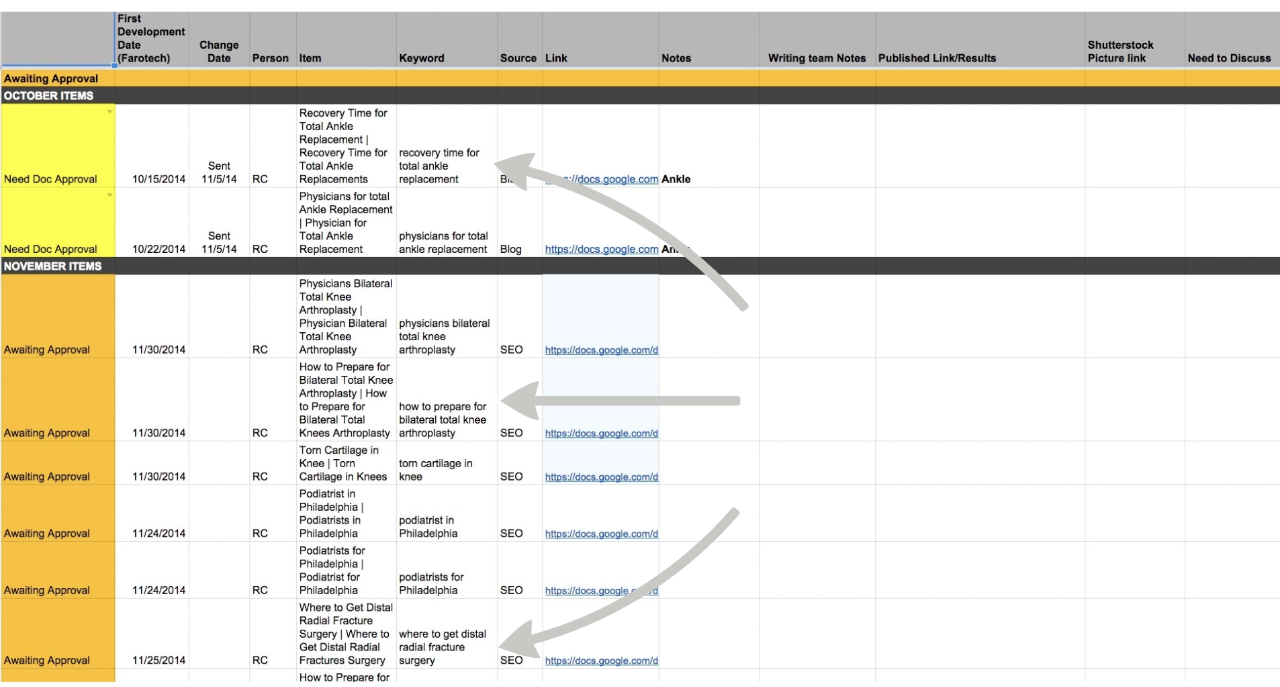Benefits of an Editorial Calendar & the Hidden Costs of Not Using One
How Do You Create an Editorial Calendar in 4 Easy Steps?
When done right content marketing is often a complex system with a ton of moving parts. However, one incredibly critical part can make all the difference, and that’s what we want to talk to you about today.
It’s kind of bizarre, but true: One of the most transformative things you can do for your marketing commonly comes down to something you can accomplish in a spreadsheet. We’re referring to the creation of an editorial calendar.
The funny thing is that 77% of companies say they have a content marketing strategy, but we rarely ever come across ones that are already leveraging the power of a content calendar. Most of these businesses believe that they’re doing content marketing, but their “strategy” is rather aimless.
If you’re ready to take a more proactive approach, keep reading. Below we’re going to outline the importance of consistently developing content that can actually transform your marketing!

Go From Reactive Marketing to Proactive Marketing
Reactive marketers lead lives of quiet desperation. They will do things like sprint to get ready for a trade show, but then take a couple of months off of their marketing efforts afterwards. They might put out a lot of effort around Christmas time, but then trail off once the holiday rush dies down.
Instead of being prepared ahead of time with 30, 60, or 90 days of regular, planned content, they take long breaks from content development, and then scramble to meet the next urgent deadline.
If you’re honest with yourself, does this description match your content marketing approach? No one sets out to be reactive with their marketing, so don’t beat yourself up too bad if this is all too relatable. Commonly, companies really struggle with consistency in content marketing. You’re not alone.
If you’re looking for a way to get organized and strategic so you can consistently put out great content throughout the year, we have good news for you. Becoming a proactive marketing could be as simple as implementing this one marketing tool.
If you’ve read “Good to Great” by Jim Collins, you know that you don’t win games by hitting home runs only. It’s more of a small ball situation. You’ve got to build consistency in hitting those singles (and doubles too).
It’s no different with marketing. In the SEO world, we don’t assume we’re going to create viral content with everything that we publish. But we know that if we publish the right kind of content consistently, we’re going to get great results in the long run.
As a thought leader in your industry, you’ve got to put out consistent, quality content, communicating regularly and working toward critical-ranking factors with Google. When you do these things, you become a proactive marketer.
The Top Tool for Creating Proactivity in Marketing: An Editorial Calendar
Creating an editorial calendar allows you and your C-suite execs to develop a plan for putting out the exact content you want in the next 30, 60, 90 days—and even through an entire year. You can set your watch by it.
It also gives you the organizational format to really get creative and thoughtful in how to create unique content ideas. Inside the same calendar, you’ll be able to plan for all types of content formats, including blogs, site pages, social media posts, etc. With all of this coordinating content marketing working together and set to a specific schedule, your results will be compounded!

Editorial Calendar Explained:
What is a content editorial calendar, exactly? Think of this spreadsheet as your most powerful tool for collaboration and organization when it comes to content planning, development, and publishing.
It allows you to account for seasonality, special events, specific campaigns, and more.
Tip: Allow yourself the freedom to keep your calendar about 80% structured and 20% nimble so that you can make adjustments on the fly whenever it’s beneficial.
What should be included in an editorial calendar?
- Types of content that will be published (blog, web page, Social Media Content, offers, etc.)
- Keyword you are targeting
- Writer responsible for each piece
- Due dates for writing, editing, and publishing
- Link to a collaborative document in Google
- Any other fields that would be helpful for your company’s particular process
So, you might be asking, “How do I make a content calendar?” We can help make this really simple for you with a free template download to get you started quick! Get your copy of an editorial calendar template here!
A 4-Step Process For Using Your Editorial Calendar

Welcome to your Hub for Content Strategy
- Writer’s Role
Each piece of content should be optimized for a specific keyword. The writer is responsible for using any provided direction, adding their own research, and developing the correct topic, format, and length for that specific piece of content. Of course, all grammar, spelling, and punctuation should also be on point! - SEO Specialists’ Role
SEO needs to be involved because metadata, links, and keyword usage/volume are important aspects of developing content that is built for search engines. SEO specialists can use analytics software to “grade” a prepared piece of content before it’s ever published, so you know exactly what should get fixed up before it’s released to the world wide web. For example, you need to know how your readability, length of content, and keyword usage look in comparison to the top 10 listings on the first page of Google. - Your Role
At this point in the process, the collaborative document would be turned over to you for any added edits, comments, or requests for changes. Using Google Documents is especially helpful for this step since the comments can be seen and addressed by anyone who has access to the link. - Publisher’s Role
Once the content is written, edited, and search engine optimized, it’s time to get it published! The publisher’s roles include proper formatting, addition of images, connecting links, and getting the content up and live on the web!
What’s the Cost of Being Reactive?
Before we talk about the cost, let’s just review the benefits. According to DemandMetric, content marketing costs 62% less than traditional marketing and generates about 3 times as many leads. 
But it is a lot of work…which is why so many marketers get behind.
When you are always a step behind, just barely keeping up with the urgent demands of online content marketing, you’ll never see the transformative power that content marketing really has when it’s done right.
It’s like that guy who never takes care of his teeth throughout the year, but right before his dental appointment, he brushes and flosses like crazy. The dentist is never fooled. And neither are his teeth. It doesn’t make a lot of sense.
It doesn’t make a lot of sense. And in the end, this strategy never works anyway. He works extra hard to make up for lost time, but the effort is futile.
It’s the same with marketing. Playing the reactive game will have you treading water and never seeing results. Being a reactive marketer has major consequences. What cost are you willing to pay?
It’s Time to Get Ahead of the Game With a Content Marketing Calendar
There’s no shortcut around effective content marketing. According to research from eMarketer, 60% of companies create at least one piece of new content each day. Your competition is out there working. You can’t afford not to be.
Take the time and create the process (with the help of an editorial calendar) to make sure you are being a proactive marketer. And, have fun watching the results!
Interested in discussing how a more organized approach to content development can help transform your marketing? Remember to download that free buffer content calendar template, and then also fill out this simple form to request a free consultation with our marketing team!
